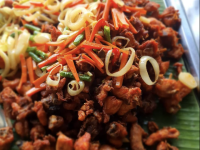Bamnut Milk:
Plant-Based Alternative: Bamnut milk is a dairy-free alternative to traditional cow’s milk, suitable for vegans and those with lactose intolerance.
Made from Bamboo: It’s produced from bamboo nuts, which are seeds found in certain species of bamboo plants.

Nutrient Profile: Bamnut milk might offer various nutrients, including calcium, vitamin D, and possibly antioxidants from bamboo.
Sustainability: Bamboo is known for its fast growth and low environmental impact, making bamnut milk a potentially sustainable choice.
Flavor: The taste of bamnut milk could be slightly nutty or earthy, depending on the processing method and any added flavorings.

Versatility: It can be used in a variety of recipes, including smoothies, cereal, baking, and cooking savory dishes.
Availability: While not as common as other plant-based milks, bamnut milk may be found in health food stores or specialty markets.
Health Benefits: Like other plant-based milks, it may offer health benefits such as lower cholesterol and reduced risk of certain diseases.
Texture: The texture of bamnut milk is likely similar to other plant-based milks, such as almond or soy milk, with a smooth consistency.
DIY Option: Some people may choose to make their own bamnut milk at home using bamboo nuts and water.

Watif Food (assuming it’s a specific cuisine or brand):
Cuisine Origin: Watif food might be associated with a specific region or culture, influencing its flavor profile and ingredients.
Signature Dishes: It likely has signature dishes or specialties that set it apart from other cuisines.
Spices and Herbs: Watif food may incorporate a variety of spices and herbs to enhance flavor and aroma.
Authentic Ingredients: Traditional watif dishes may feature authentic ingredients sourced from the region of origin.
Culinary Techniques: The cuisine may involve unique cooking methods or culinary techniques passed down through generations.

Health Considerations: Watif food might prioritize fresh, wholesome ingredients and cooking methods for a balanced and nutritious diet.
Influence of Culture: The culture surrounding watif food could influence dining customs, meal times, and social gatherings.

Regional Variations: Different regions within the cuisine’s origin may have their own variations and specialties.
Popularity: Depending on its accessibility and exposure, watif food may have gained popularity locally or internationally.
Restaurant Recommendations: If you’re interested in trying watif food, researching reputable restaurants or seeking recommendations from locals can enhance your dining experience.






















0 Comments